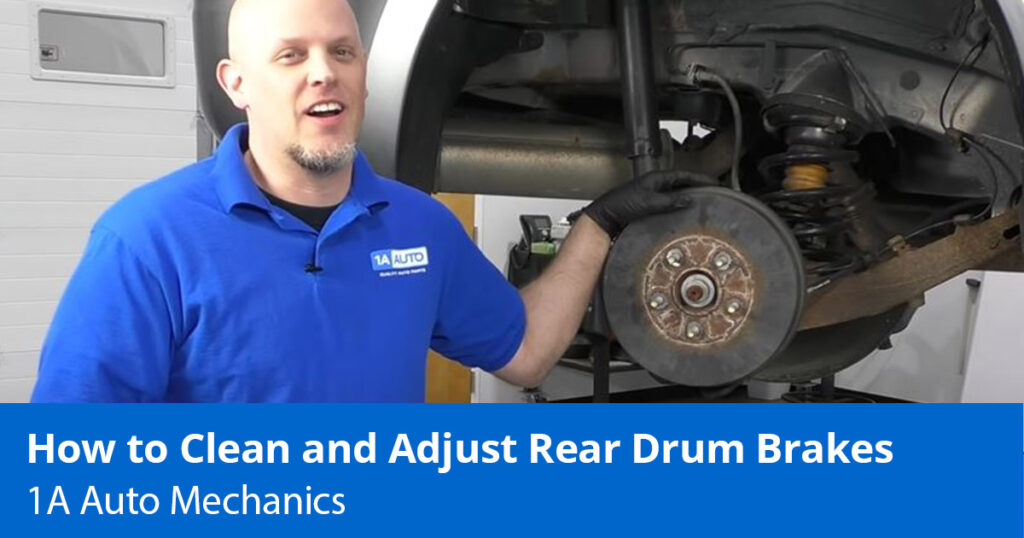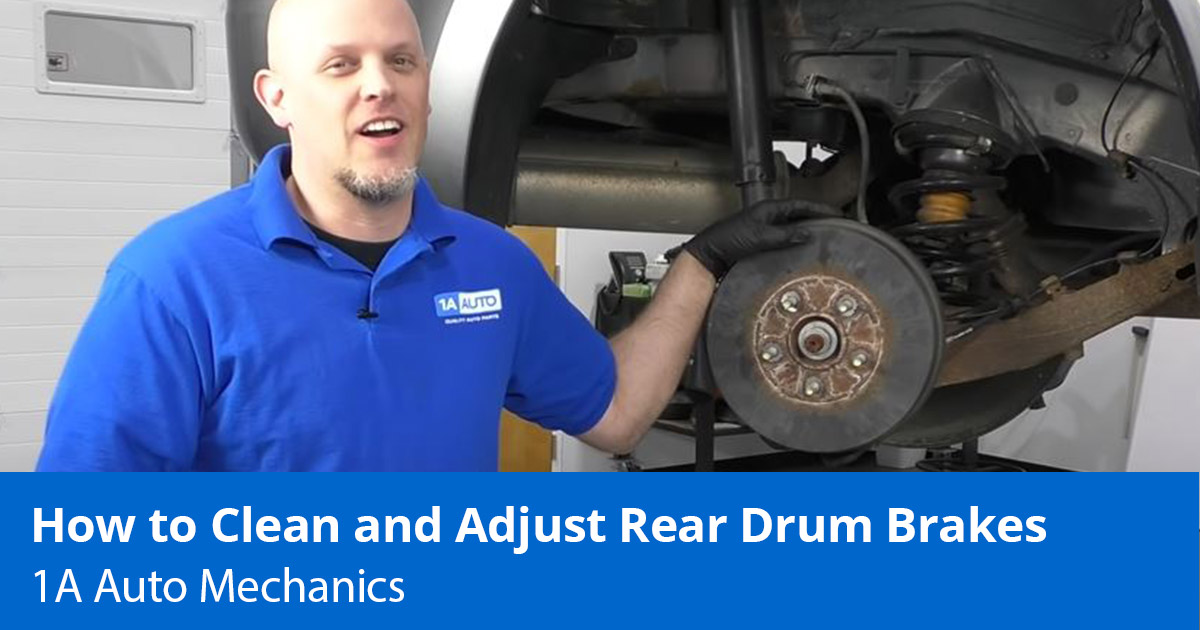How To Set Drum Brakes

If your vehicle has drum brakes and you have a soft restriction pedal, it might be fourth dimension for a drum brakes aligning. The drum brakes can be adjusted with a few simple tools. This post and video explains how to adjust the drum brakes yourself as well as make clean them.

How Practice I Know I Need to Adjust the Drum Brakes?
If your vehicle has pulsate brakes and yous're driving downwards the road, you may feel the restriction pedal soften over fourth dimension when pressed. Sometimes that's from a malfunctioning self-adjuster. If the cocky-adjuster is having difficulty functioning, the rear pulsate brakes will demand to be cleaned and re-adjusted. Giving the rear drum brakes an adjustment will help improve and make for safer braking.
Tools Needed to Clean and Adjust the Rear Drum Brakes
Items Needed
- Mask
- Gloves
- Ball peen hammer
- Pliers
- Flat bract screwdriver
- Brake parts cleaner
- Jack and jack stands
- Breaker bar
- Metric socket set
Steps for a Rear Pulsate Brake Aligning
This procedure is very similar for most vehicles
1. Remove the Rear Brake Drum
General Steps for How to Remove the Rear Drum Brakes
- Plough the Parking Brake Off
Make sure the parking brake is off. Removing the brake drums with the parking brake on tin can change the adjustment or make it hard to remove the brake drum.
- Jack Upwardly the Vehicle and Remove the Tire
Loosen the lug nuts with the vehicle on the ground, heighten the vehicle with a jack and jack stands, remove the lug basics and tire
- Remove Clips from the Lug Nut Studs
Take off any clips from the lug nut studs with pliers by twisting and breaking them off

- Remove the Restriction Drum Rotor
Remove the restriction drum.
If the brake drum is stuck tight, strike around the flat areas betwixt the lug nut studs with a ball peen hammer to loosen it. Endeavor not to hit the studs. This should help restriction whatever corrosion or rust that might be stuck to the restriction drum.
Pro Tip: Remove the brake drum carefully. There volition be a lot of brake dust in the brake pulsate that should not be inhaled. Wearing a mask can aid prevent inhaling these particles.
two. Check the Condition of the Brake Shoes and Adjuster
Check the Status of the Brake Shoes

Measure the thickness of the brake shoes with a brake pad material measuring tool.
Brake shoes last a lot longer than brake pads practise, so information technology'south normal for them to not vesture equally quickly as brake pads. Make certain the friction pad textile is connected and lined to the brake shoe. Gently grab and pull the brake shoes to check for looseness. If the brake shoes are in bad status, replace them.
Check the Condition of the Adjuster

Wearing a mask, check the wheel cylinder for leaks.
Elevator the grit boots on the adjuster with a flat blade screwdriver without ripping or distorting information technology. See if the adjuster is dry. If the adjuster is leaking, replace it.
iii. Clean the Brake Shoes and Drum

Spray all around the brake parts and coat them with restriction parts cleaner without inhaling it or any of the dust that's airborne. A take hold of pan or fabric can help grab any brake parts cleaner.
Spray the inside surface of the brake pulsate with brake parts cleaner in a well-ventilated surface area. Wipe the parts cleaner off with a rag or paper towel. Permit the brake drum dry.
4. Adjust the Brake Shoes

Find the adjuster. The adjuster wheel should spin the tighten the pads. Sometimes the adjuster wheel can fail.

Turn the adjuster wheel with a flat bract screwdriver (in this case turning the adjuster wheel upwards tightens the shoes). Count and remember the revolutions or clicks the adjuster wheel makes. So, with the restriction shoes dry, lift the brake drum and plow it, feeling for elevate. It helps to have the brake pulsate on the opposing side removed, since sometimes it tin experience similar the brake shoes are secure and tight enough but really take drag coming from the opposite side.
If the brakes have been adjusted also tightly, turn the adjuster bike in the reverse direction. In this case we push on the lever in the dorsum with 1 screwdriver for the automatic role and turn the adjuster bike down to loosen the shoes.

On some brake drums, brake shoes tin be loosened from a door behind the backside pulsate with a screwdriver or a special tool called a spoon that is bent and congenital for this specific task.

When the brake drum and shoes are tight enough to create resistance but still loose enough and then the brake drum tin motility and spin, bank check and heart the brake shoes and reinstall the brake drum.
Related Content
- How Long Practice Brakes Commonly Last?
- How to Bleed Brakes Past Yourself
- Why Are My Brakes Sticking?
- Why is My Parking Brake Not Working?
Store Brake Parts and More than
- Brakes & Wheel Bearing
- Engine & Engine Management
- Tools & Accessories
- Restriction Tools
Summary

Article Name
Rear Drum Brakes Adjustment - How to Clean and Adjust Pulsate Brakes
Description
If your brake pedal is soft and you have rear drum brakes, information technology might exist time for a rear drum brake aligning. Our expert mechanics explain how to adjust and clean the rear pulsate brakes in this article and video
Author
1A Auto Team
Publisher Name
1A Auto
Publisher Logo

Source: https://blog.1aauto.com/rear-drum-brakes-adjustment-clean-adjust-rear-drum-brakes/

0 Response to "How To Set Drum Brakes"
Post a Comment